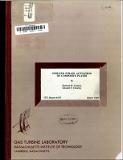| dc.contributor.author | Lazarus, Kenneth B. | en_US |
| dc.contributor.author | Crawley, Edward F. | en_US |
| dc.contributor.other | Massachusetts Institute of Technology. Gas Turbine Laboratory | en_US |
| dc.date.accessioned | 2016-10-06T21:22:18Z | |
| dc.date.available | 2016-10-06T21:22:18Z | |
| dc.date.issued | 1989 | en_US |
| dc.identifier.uri | http://hdl.handle.net/1721.1/104737 | |
| dc.description | March 1989 | en_US |
| dc.description | Originally written by Mr. Lazarus as: Thesis (M.S.)--Massachusetts Institute of Technology, Dept. of Aeronautics and Astronautics, 1989 | en_US |
| dc.description | Includes bibliographical references (pages 126-128) | en_US |
| dc.description.abstract | Two models of induced strain plate actuator/substrate systems are developed and verified experimentally. Equations relating the actuation strains produced by the strain actuators to the induced strains found in the system are derived for both models. In addition, the plate strain energy relations are also developed. Exact and approximate solutions are formulated for isotropic and anisotropic plate systems. Exact solutions are found for actuator/substrate systems with free-free, free-free boundary conditions, and a general procedure for solving the strain energy equations with a Rayleigh-Ritz approximate solution is formulated for systems with arbitrary boundary conditions and external loads. Specific solutions are detailed for cantilever plate systems, including a discussion of the assumed modes selected. A model for predicting the actuation strains produced by a specific class of induced strain actuators, piezoceramic actuators, is also developed. | en_US |
| dc.description.abstract | The non-linear properties of piezoceramics are discussed and the important effects of such non-linearities are accounted for by developing a strain dependent model for the actuation strains created in piezoceramics. The models developed were verified through experimentation via two sets of plate test articles. The first set of simple test articles were used to verify the accuracy of the basic induced strain actuation models, the strain dependence of piezoceramic actuation strains, and a semi-empirical solution procedure. The second, more representative, set of large cantilever plate test articles verified the ability of the models to predict the strains induced in systems with extensive stiffness couplings and complicated boundary conditions, and the Ritz model. | en_US |
| dc.description.abstract | Agreement between the solutions predicted by the induced strain actuator models and the experimentally measured deformations was excellent, verifying the effectiveness of using induced strain actuation for shape control of structures such as aeroelastic lifting surfaces and components of intelligent structures. | en_US |
| dc.description.sponsorship | Sponsored by General Dynamics Corporation and the Allison Gas Turbine division of General Motors Corporation | en_US |
| dc.format.extent | 128 pages | en_US |
| dc.publisher | Cambridge, Mass. : Gas Turbine Laboratory, Massachusetts Institute of Technology, [1989] | en_US |
| dc.relation.ispartofseries | GTL report #197 | en_US |
| dc.subject.lcc | TJ778.M41 G24 no.197 | en_US |
| dc.subject.lcsh | Actuators | en_US |
| dc.subject.lcsh | Strains and stresses | en_US |
| dc.subject.lcsh | Deformations (Mechanics) | en_US |
| dc.title | Induced strain actuation of composite plates | en_US |
| dc.title.alternative | Composite plates, Induced strain actuation of | en_US |
| dc.type | Technical Report | en_US |
| dc.identifier.oclc | 21504011 | en_US |
